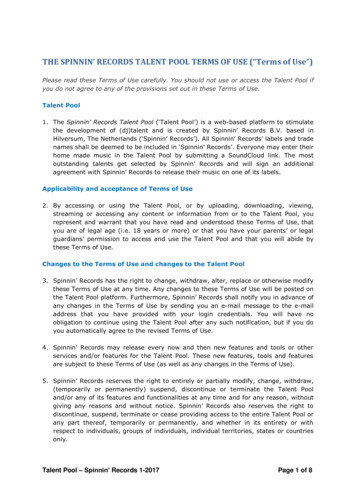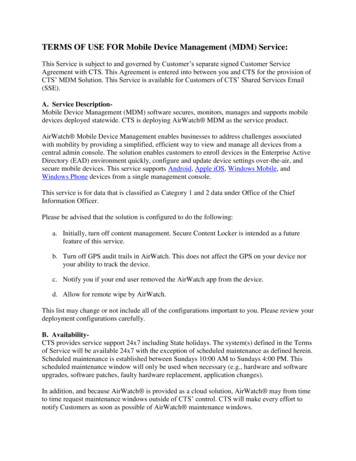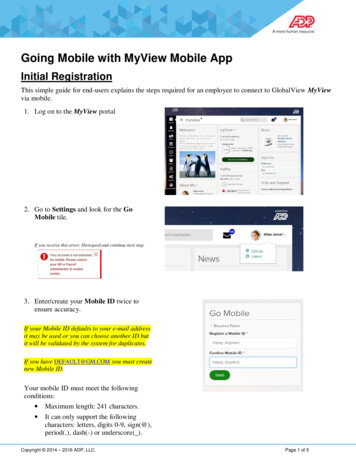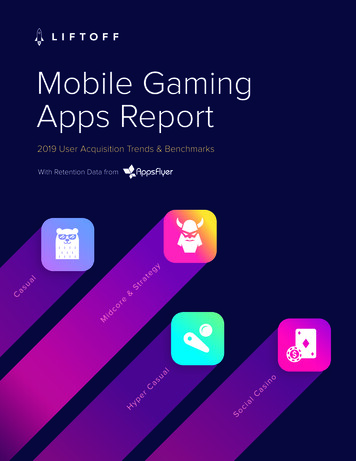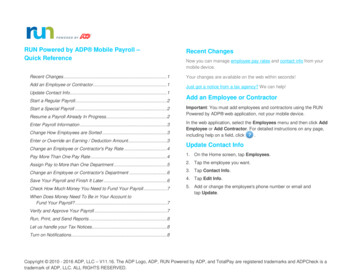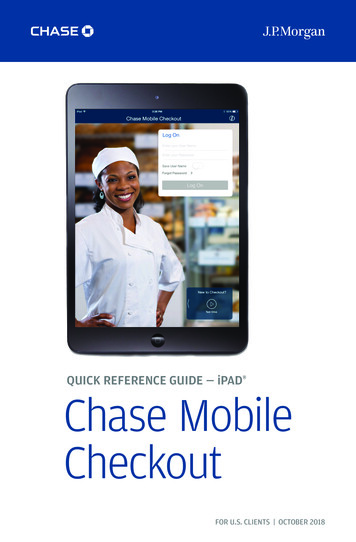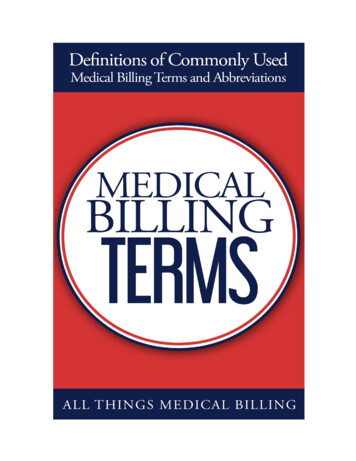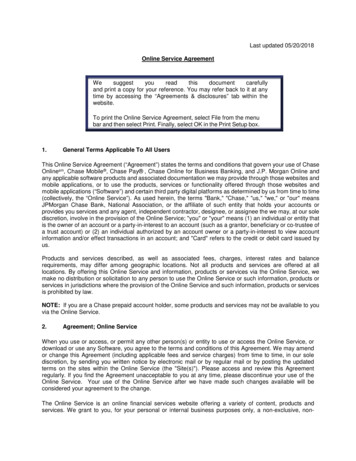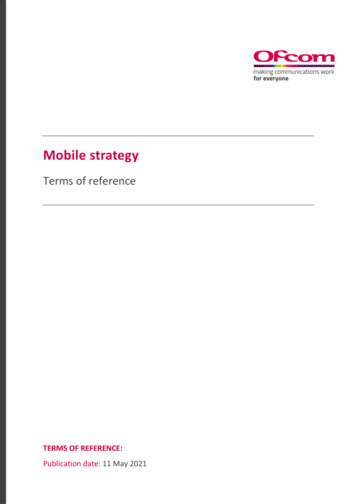
Transcription
Mobile strategyTerms of referenceTERMS OF REFERENCE:Publication date: 11 May 2021
Mobile Strategy – Terms of reference1. Terms of referenceIntroduction1.1Ofcom is launching a strategic review of its approach to markets that deliver mobileservices. This document sets out the terms of reference for the review.1.2We rely increasingly on mobile services for many aspects of everyday life, including work,keeping in touch with friends and family, getting around and entertainment. As a result,every year we use more and more mobile data, 1 and the Covid-19 pandemic has furtheremphasised how critical it is to be connected.1.3Network providers need to meet our current demand for services and, importantly, theyalso need to invest in new technologies to meet future needs. In the UK, the nationalmobile network operators (MNOs) are rolling out their 5G networks. Initially, the key driverhas been to provide enhanced capacity for existing services in busy areas. But as 5Gcontinues to be rolled out, and is combined with new devices and technologies, we canexpect to see new uses develop, which will further enhance the way we live, work andtravel. In particular, new technologies are opening up possibilities for mobile to be at theheart of industrial use cases, driving innovation and efficiency beyond the mobile sector.1.4Overall, we see many changes taking place across the mobile landscape, which may impacton the current national MNO business model. There has already been a blurring of the linebetween fixed and mobile networks, 2 and factors such as the development of newindustrial uses and private networks, the use of systems integrators and the growing roleof large tech companies, mean that the current business model and broader landscapemay look quite different in 10 years’ time.1.5Against this background, we plan to develop a clear strategic framework within which wemake future regulatory decisions. This framework will take account of marketdevelopments to support competition, ongoing investment and innovation, and helpensure that the market delivers good outcomes for people and businesses throughout theUK. We intend to gather evidence and views from a wide range of stakeholders, so that wedevelop a holistic view of the challenges and opportunities facing the industry, and howthese could affect people and businesses.The total amount of data consumed over mobile networks in the UK increased by 243% in the last five years. Source:figure calculated from Ofcom Telecommunications Market Update Q4 2020, Mobile Table 2 Call and message volumes bycall type (billions of minutes/messages/PB)2 For example, MNOs rely on fixed core networks and fixed telecoms providers for backhaul; customers often use WiFi toconnect to fixed broadband on their mobile devices.11
Mobile Strategy – Terms of referenceOur current approach to the mobile sector1.6Ofcom is the UK’s communications regulator. We seek to further the interests of citizensand consumers, where appropriate by promoting competition. Our current strategicpriorities 3 include: supporting investment in strong, secure networks. We want to support ongoinginvestment in faster broadband, and high-quality mobile networks, as well as to ensurethat communications networks are safe, secure and resilient;getting everyone connected, so that people and businesses can access keycommunications services; andensuring fairness for customers so that people shop around with confidence, makeinformed choices, switch easily and get a fair deal.1.7Within this broader context, our current approach to the mobile sector is primarily tosupport competition among vertically integrated providers, the MNOs, and a range ofresellers. 4 This competition encourages providers to invest, innovate and deliver theservices that customers want, both now and in the future.1.8We have sought to support such competition as far as possible and, where necessary, tointroduce specific additional measures to help ensure that the market delivers a range ofgood outcomes for people and businesses. The additional steps we have taken largelyrelate to the release of spectrum, which is critical to the provision of mobile broadband;improving network coverage beyond that which would be delivered by commercial rolloutalone; and measures to ensure customers are treated fairly and can find the best dealmore easily. In the mobile sector, wholesale price regulation is limited to regulation of therates MNOs can charge to terminate mobile calls.1.9Our approach has helped the market deliver substantial benefits to people and businesses.For example, just over four fifths (82%) of the adult population now has a smartphone; 5and, for many (60%), this has become the most important device for connecting to theinternet, at home or elsewhere. 6 Average mobile data use grew by 146% between 2016and 2019, while prices fell by almost 20%. 7 Outdoor 4G data services from all MNOs areavailable at 97.5% of UK premises and almost all UK premises have coverage from at leastone MNO. 8 Overall, nine in ten (90%) mobile customers are satisfied with their mobileprovider. 9Ofcom, March 2021, Ofcom’s plan of work 2021/22.Ofcom last carried out a strategic review of the mobile sector as part of the Strategic Review of Digital Communications,which confirmed this approach.5 Source: Ofcom Technology Tracker. Base: All adults (2015, 3756) (2016, 3737) (2017, 3743) (2018, 3730) (2019, 3909)(2020, 3959). Note: Take-up of smartphone relates to personal take-up.6 Source: Ofcom Technology Tracker QE40. Which is the most important device you use to connect to the internet, at homeor elsewhere? “Other” responses include: “Netbook”, “Games console”, “E-reader”, “TV set”, “Smart watch”, “Otherportable/handheld device”, “Other device”, “None” and “don’t know”.Base: All adults aged 16 who use the internet at home or elsewhere (n 3422 UK).7 Page 3, Pricing trends for communications services in the UK (ofcom.org.uk).8 Ofcom, December 2020, Connected Nations 2020: UK report.9 Ofcom, May 2021, Comparing customer service: mobile, home broadband and landline.342
Mobile Strategy – Terms of referenceWhy we are carrying out a review1.10We are launching a review in recognition of the importance of mobile services, and theneed for innovation and ongoing investment in new technologies to keep pace with thegrowing demands of people and businesses.1.11We want to take stock of the significant changes that are taking place within the existingmobile sector, 10 as well as outside it. These changes include the following: A growing demand for high-quality mobile connectivity. Having reliable mobileservices is already important for people and businesses, wherever they are.Nonetheless, we expect to see a growing demand for high-quality mobile connectivityas, for example, video usage grows and people expect to watch such content on-the-goon mobile networks (as well as on fixed networks). This demand may be further drivenby the development of innovative new uses for mobile connectivity, such asaugmented and virtual reality, particularly if they become mass market applicationsthat are used on-the-go. On the business side, some new industrial use cases are likelyto require high-quality connectivity – in particular high speeds and responsiveconnections without delay. 11 As a result, MNOs need to continue investing to rolloutnetworks, expand capacity, and deploy new technologies where they are needed,including 5G.Changing customer behaviour. We are already seeing changes to both what peoplebuy and where they buy it, with a shift from bundled airtime and device contracts toSIM-only contracts, and a shift from the use of high street retail stores to online. In thefuture, national mobile connectivity may become a smaller part of the broader servicereceived by customers, and we could see a shift from buying directly from mobileproviders to buying indirectly through fixed-mobile service bundles or throughapplication providers such as the large tech companies.Changes to the mobile business model. The national MNO business model haswithstood a number of market developments to date, including a significant growth inthe importance of services provided by others over mobile networks. However, futuretrends may prove to be more disruptive. There is scope for changes such as thebundling of mobile connectivity with other services sold by different service providers,and for the emergence of alternative providers of connectivity (such as localisedservice providers) to change the role of the national MNOs.MNO revenues have been impacted by these changes. Total mobile retail revenue hasbeen relatively stable in real terms over the last few years, 12 but average revenue perIn the UK this has been based on network competition from 4 national MNOs with 2 network sharing agreements, andretail competition among the MNOs and a range of resellers, with customers typically buying their mobile services anddevices from the MNOs and resellers.11 Examples include bespoke networks in warehouses which allow packing robots to send and receive instructions from acentral computer multiple times a second and avoid collisions; and improved real-time monitoring of patients in healthcareremotely in connected ambulances.12See Communications Market Interactive report, though changes in reporting make it difficult to compare revenues overtime.103
Mobile Strategy – Terms of referenceuser has generally been declining. 13 This comes at a time when MNOs need to invest in5G networks and implement new security requirements, as well as ensure sufficientdiversification of providers in the supply chain. MNOs are seeking to grow theirrevenues, for example by selling bigger data packages, fixed-mobile bundles, and 5Gdevices.1.12In light of these changes, it is timely to take a holistic look at how the market operates,how it is likely to evolve, and the extent to which it is likely to deliver good outcomes forpeople and businesses.Purpose and scope of the review1.13The overall aim of this review is to ensure that the markets that deliver mobile serviceswork well for people and businesses over the next five to 10 years, as technologies developand the market changes.1.14Specifically, we want to develop a strategy for our approach to the sector that supports thedelivery of high-quality connectivity and innovation, to meet people’s and businesses’needs in the future. We intend to consider the following key areas: 1.1513What will good outcomes for people and businesses look like in five to 10 years’time? We will consider how people’s and businesses’ use of mobile is likely to evolve,including what new uses might become possible due to changes in technology. This willinform our view of the high-level outcomes we should be trying to achieve. As part ofthis, we will take into account the ongoing challenges that some customers face inobtaining good mobile connectivity.What impact are changes across the mobile value chain having on the market? Inlight of the significant changes that are taking place, we will look at how competitionoperates at different levels of the mobile value chain. We will consider how the valuechain may change (both vertically and horizontally) over the next five to 10 years, andthe potential impact of those changes. As part of this, we will consider the businesscase for investment in mobile network connectivity, as well as the implications ofmarket developments for innovation.To what extent is the market likely to deliver good outcomes for people andbusinesses? We will consider whether there are any barriers to the market deliveringgood outcomes, and whether any existing regulation might need to be revised to helpensure the delivery of those outcomes.A key benefit of this work will be a holistic view of how the mobile market operates andhow Ofcom can best contribute to the delivery of good outcomes for people andbusinesses.Ofcom, based on confidential MNO submissions.4
Mobile Strategy – Terms of referenceLinkages to existing policy development1.16The project will need to take account of, and work alongside, the ongoing process ofexisting policy development and enforcement, which will continue. This includes ourongoing spectrum work (such as planning for future spectrum requirements, which willconsider the potential future needs of the mobile sector), as well as other ongoing work inareas such as mobile coverage, supply chain diversification and net neutrality. 14Timescales and approach1.17Our approach will depend in part on the outcome of our engagement with stakeholders.However, we anticipate at least two main phases of work: 14Phase 1: evidence gathering, stakeholder engagement and discussion. We will engagewith a wide range of stakeholders and gather evidence to inform our analysis, includingon how people’s and businesses’ use of mobile connectivity might develop and whatoutcomes they might want to see; the impact that changes to the mobile value chainare having on the market; and the extent to which the market is likely to deliver goodoutcomes. We intend to complete this phase of work with the publication of adiscussion paper in Q3 2021/22.Phase 2: further analysis, initial views and any next steps. Building on stakeholderresponses, we intend to publish a document setting our initial conclusions and any nextsteps in Q1 2022/23.See Ofcom’s plan of work 2021/22 for more details.5
Ofcom’s plan of work 2021/22. 4. Ofcom last carried out a strategic review of the mobile sector as part of the . Strategic Review of Digital Communications, which confirmed this approach. 5. Source: Ofcom Technology Tracker. Base: All adults (2015, 3756) (2016, 3737) (2017, 3743) (2018, 3730) (2019, 3909) (2020, 3959). Note: Take-up of smartphone relates to personal take-up. 6. Source: Ofcom
